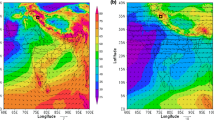Abstract
Data from monitoring electrical field in the surface air layer in Tomsk in 2006–2017 are used to study their slow variations associated with the passage of cumulonimbus (Cb) clouds and accompanying weather phenomena in the warm and cold seasons. A total of 453 and 210 episodes for warm and cold seasons, respectively, were considered. Slow variations in the gradient of electric field potential are statistically analyzed. The distribution of the total duration of slow variations in the gradient of potential is shown to be well described by the power-law distribution (Pareto distribution). This distribution is approximated by two-segment line in the warm season, and one-segment line, in the cold season.
Similar content being viewed by others
References
N. P. Tverskoi, Atmospheric Elictricity (Gidrometeoizdat, Leningrad, 1949) [in Russian].
J. A. Chalmers, Atmospheric Electricity (Pergamon Press, Oxford, 1967), 2nd ed.
K. N. Pustovalov and P. M. Nagorskii, “The main types of electric field variations during the passage of cumulonimbus clouds of different genesis,” Opt. Atmos. Okeana. 29 (8), 647–653 (2016).
A. X. Filippov, Thunderstorms in Eastern Siberia (Gidrometeoizdat, Leningrad, 1974) [in Russian].
W. D. Rust, The Electrical Nature of Storms (Oxford Univ. Press, New York, 1998).
V. A. Rakov and M. A. Uman, Lightning: Physics and Effects (Cambridge Univ. Press, Cambridge, 2003).
A. J. Bennett and R. G. Harrison, “Atmospheric electricity in different weather conditions,” Weather 62, 277–283 (2007).
I. B. Popov, “Statistical estimates of the effects of different meteorological phenomena on the gradient of the electric potential of the atmosphere,” Trudy GGO, Is. 558, 152–16. (2008).
T. C. Marshall, “Electrical evolution during the decay stage of New Mexico thunderstorms,” J. Geophys. Res. 114, D02209 (2009).
A. A. Toropov, V. I. Kozlov, V. A. Mullayarov, and S. A. Starodubtsev, “Experimental observations of strengthening the neutron flux during negative lightning discharges of thunderclouds with tripolar configuration,” J. Atmos. Sol.-Terr. Phys., No. 94, 13–18 (2013).
I. M. Imyanitov, E. V. Chubarina, and Ya. M. Shvarts, Cloud Electricity (Gidrometeoizdat, Leningrad, 1971) [in Russian].
S. M. Shmeter, Thermodynamics and Physics of Convective Clouds (Gidrometeoizdat, Leningrad, 1987) [in Russian].
H. B. Bluestein, Severe Convective Storms and Tornadoes: Observations and Dynamics (Springer, Berlin, Heidelberg, 2013).
P. K. Wang, Physics and Dynamics of Clouds and Precipitation (Cambridge Univ. Press, Cambridge, 2013).
R. A. Houze, Cloud Dynamics (Acad. Press, New York; London, 2014), 2nd ed.
P. M. Nagorsky, V. N. Morozov, S. V. Smirnov, and K. N. Pustovalov, “Electrode layer in the electric field of deep convective cloudiness,” Izv. vuzov, Radiofiz. 56 (11), 853–863 (2013).
P. M. Hobbs, “Organization and structure of clouds and precipitation on the mesoscale and microscale in cyclonic storms,” Rev. Geophys. Space Phys. 16 (4), 741–755 (1978).
S. M. Shmeter, “Characteristics of submerged convection in frontal clouds and conditions for its formation,” Meteorol. Gidrol., No. 11, 36–44 (1990).
Author information
Authors and Affiliations
Corresponding author
Additional information
Original Russian Text © K.N. Pustovalov, P.M. Nagorskiy, 2018, published in Optika Atmosfery i Okeana.
Rights and permissions
About this article
Cite this article
Pustovalov, K.N., Nagorskiy, P.M. Comparative Analysis of Electric State of Surface Air Layer during Passage of Cumulonimbus Clouds in Warm and Cold Seasons. Atmos Ocean Opt 31, 685–689 (2018). https://doi.org/10.1134/S1024856018060131
Received:
Published:
Issue Date:
DOI: https://doi.org/10.1134/S1024856018060131



